Chrysler Crossfire Roadster Convertible Blue Pearl CREAM SLK Mercedes Chassis
2005 Chrysler Crossfire
Chrysler Crossfire 2005 technical specifications | |
|---|---|
| Condition: | Used |
| Item location: | Beverly Hills, California, United States |
| Make: | Chrysler |
| Model: | Crossfire |
| Type: | Convertible |
| Year: | 2005 |
| Mileage: | 78,700 |
| VIN: | 1C3AN65L05X054011 |
| Color: | AERO BLUE PEARL |
| Engine size: | V6 |
| Number of cylinders: | 6 |
| Power options: | Air Conditioning, Cruise Control, Power Locks, Power Windows, Power Seats |
| Fuel: | Gasoline |
| Transmission: | Automatic |
| Drive type: | REAR |
| Interior color: | CREAM AND BLACK |
| Safety options: | Anti-Lock Brakes, Driver Airbag, Passenger Airbag, Side Airbags |
| Options: | Convertible |
| Vehicle Title: | Clear |
| You are interested? | Contact the seller! |
Description |
|---|
Please note: There is a blemish on the front bumper. I have purchased a brand new bumper from the dealer and it comes with the car. I wanted to keep the original bumper on the car so the buyer could see it for themselves but also know the car comes with a brand new bumper as well.
New upgraded tires and battery fitted within the past year. Serviced with Mobile 1 Synthetic Oil.
Super rare limited production and likely a future collectors car with just around 30k Roadsters made for the world.
This Crossfire derives directly from the Concept car that actually went into production. It is based on the Mercedes SLK so it has all the top quality engineering you expect from a Mercedes.
The Magazine's that reviewed the car commented on its stunning looks and excellent construction. More information in general is below.
This car is lady driven and her daily driver. It has been 100 percent reliable. It has larger upgraded performance tires that we put on to ensure the wheels didn't get any curb rash. They are sized 245 in the front and 275mm in the rear.
Power top, power windows, heated seats, Air Conditioning, Power Seats, leather seats, performance suspension, alarm, etc.
Gets nearly 30 mpg cruising on the highway.
Excellent condition. Sold As is.
Developed during the union of Daimler and Chrysler, the two-seater is based on the R170 platform and shares 80% of its components with the R170 Mercedes-Benz SLK320. The 2nd generation Mercedes-Benz SLK was built on a new R171 platform starting in the 2005 model year. The R170 platform was essentially handed down to Chrysler for use in building the Crossfire. Having initially arrived in 2001 as a concept car styled by Eric Stoddard,[3] the Chrysler was further refined by Andrew Dyson[4] before production began in 2003 for 2004 model year sales.
The name "Crossfire" refers to the two character lines that run from front to rear along the body sides — crossing each other midway through the door panel. Conceived during the period of Chrysler's ownership by Daimler-Benz, the name also refers to the collaboration of the two companies.
The Crossfire's fastback roof and broad rear fenders made for a rear end design that prompted automotive journalists and writers to compare the new car to American Motors' 1965–1967 Marlin.[5] The "distinctive boat-tail rear end that reminds more than one observer of the old Rambler Marlin."[6] For example, Rob Rothwell wrote "... when I first espied the rear lines of the Chrysler Crossfire I was instantly transported back to 1965 and my favorite car of that year, the Rambler Marlin."[7] Motor Trend also compared the "provocative boattail theme" of the 2004 Crossfire's sheetmetal to that of the AMC Marlin.
Chrysler executed the interior and exterior styling. All other elements of the car such as wheelbase, track, engine, transmission, chassis structure, suspension components, are shared with the R170 platform.[10] An example of this is the engine bay of the Crossfire, which is virtually identical to the Mercedes-Benz SLK320 on the R170 platform. The seats from the Mercedes-Benz SLK320 would bolt directly into the Crossfire chassis. The dashboard layout, controls and instruments are also similar to those on the Mercedes-Benz SLK320.
The standard transmission is a 6-speed manual with an optional 5-speed automatic. Base (Standard) and Limited models, originally sold beginning in the 2004 model year, are equipped with a Mercedes-Benz 3.2 L, 18-valve, SOHC V6 engine which produces 215 hp (160 kW) and 229 pound force-feet (310 N·m) of torque. The 5-speed automatic transmission in the Crossfire (known as 5G-Tronic) is also Mercedes sourced and a variant of the 722.6 family. The automatic achieves a better EPA fuel efficiency rating over the 6MT, mostly due to the difference in gear ratios.
Unlike most cars of its time, the Crossfire does not use a rack and pinion steering system; instead, it utilizes a recirculating ball system as employed on the donor R170 platform.[10] Front suspension is unequal length (SLA) double wishbone suspension with 5 point multi link in the rear.[11] All Crossfire models were built with 2 different wheel sizes, the front wheels are 18-in. x 7.5-in. with 225-40/18 tires and the rear wheels are 19-in. x 9-in. with 255-35/19 tires.
The first production Crossfire was driven off the assembly line on 3 February 2003, by Chrysler Group's COO Wolfgang Bernhard in Germany.[12]
The Chrysler Crossfire was a very well-equipped sports car, even in base form, and included standard features such as large alloy wheels with performance-rated tires, a Becker (part of Harman / Kardon)-sourced A/M-F/M stereo with anti-theft and a single-disc CD player, keyless entry with security alarm, a power-retractable rear wing spoiler, leather-trimmed seating surfaces, dual power front sports bucket seats, full instrumentation, a 3.2L V6 engine with manual transmission, Rear-Wheel-Drive (RWD), a leather-wrapped and stitched steering wheel, a power-retractable cloth convertible roof (for convertible models), front floor mats, and air conditioning.
++++++++++++++++++++++++++++++++++++++++
MOTOR TREND
2005 Chrysler Crossfire Roadster
In the status game, a trophy car works better in convertible form.
Jun 2004 By BARRY WINFIELD
In the Rolling Stones song "Jumpin' Jack Flash," Mick Jagger sings about being born in a crossfire hurricane. We're not sure what a crossfire hurricane is, but we know a Crossfire roadster when we see one, and it's a gas, gas, gas. After all, there's not much wrong with the proposition of an Austrian-built convertible with distinctive styling and the mechanical underpinnings of a Mercedes-Benz SLK beneath the surface. Especially at a price about 10 grand cheaper than the Mercedes original.
Well, okay, there are a few things on the negative side of the report card, but they're probably not bad enough to dissuade affluent buyers from this "reward" purchase. In February, even before the roadster version hit showrooms, Chrysler's Crossfire coupe was enjoying greater sales than its most obvious rivals, the Audi TT and the BMW Z4, in the trophy-car segment. Since this kind of car works better as a convertible in the status game, the DaimlerChrysler sales picture is likely to get even better.
Chrysler's advance vehicle engineering guys say the roadster was developed concurrently with the coupe. That allowed the engineers to anticipate any structural discontinuities in the topless car and have some of the reinforcements in place from the outset. The project was clearly aided by the fact that the donor SLK floorpan was designed for that car's convertible mission.
The stiff cowl, the cross-car bulkhead behind the seats, and the transmission tunnel resist bending and torsional forces quite well. They do it even better when helped along by 100 or so pounds of metal straps and gussets that Chrysler added to the roadster's structure. Subjectively, the new car feels extremely stiff.
Chrysler's designers thought it crucial that the roadster look good with the top up or down. We think they achieved that goal, even retaining the coupe's rear boattail design to great effect. The backlight is heated glass, and necessarily quite small, producing blind spots at the rear three-quarter aspect with the top up. Of course, this little inconvenience evaporates like cigar smoke in the slipstream when the top's down.
The top takes about 22 seconds of dancing fabric, waving panels, and articulating frames to stow itself, ending up completely concealed under a tidy tonneau cover. It's not quite fully powered, requiring the manual release of a slightly awkward lock handle and an upward push to initiate the action. Closing the softtop takes a few seconds longer and requires you to pull down and twist that same handle.
The cover sports a pair of fairings à la Ferrari 360 Spider, and thick satin-silver sport bars flank a clear-plastic wind blocker behind the headrests. (Don't say roll bars—lawyers might be listening.)
These add visual jewelry to the rear deck, accessorized by a stinger radio antenna and a cheeky tail spoiler that deploys at speeds above 60 mph. Predictably, the retracting top reduces the Crossfire's luggage capacity from eight cubic feet to seven and shrinks the trunk aperture to a narrow mail slot. As befits toys of this type, custom luggage is available.
The convertible actually offers better headroom, with its straighter roofline and lack of a headliner, and since it doesn't weigh much more, its performance should closely resemble the coupe's respectable achievements. Roadster estimates include 0-to-60-mph sprints in the 6.8-second area and quarter-mile dashes in about 15.1 seconds.
Chrysler touts the 229 pound-feet of torque on tap from the standard 3.2-liter V-6 as trumping that churned by the BMW Z4 3.0 or the Audi TT 1.8T–but the Crossfire is more handler than screamer. In Motor Trend’s instrumented testing, the Coupe slaloms through the cones with some serious company at 66 mph. The Roadster is right behind. Chrysler engineers did an impressive job of stiffening the topless chassis, with reported top speed testing to 150. It’s surprising they added less than 100 pounds of additional curb weight in the process.
ROAD & TRACK
The convertible is a much more balanced-looking car, top up or down. The glass backlight of the top hits just behind the seats, giving the car less of a cab-backward look. Designers have done an admirable job of retaining the boattail, incorporating a new high-mounted brake lamp and slightly larger deployable rear spoiler, which now operates more quietly.
There are two rear decklids; one that accepts luggage from the rear and the other that houses the top. The forward tonneau is sculpted with twin headrest fairings, while two sport hoops over the headrests add a bit of sparkle. The cloth top provides an additional inch of head room, partially addressing concerns of the over-6-ft. set that the car was a tight fit. This additional head room, thanks to the single-layer cloth design, comes at the expense of some wind noise when the top is up.
But when the automatic top is down (it takes about 22 seconds after the header latch is manually released and a button is pushed), the Crossfire convertible comes into its own. The body structure is stiff, there's little cowl shake and the wind protection is pretty good, although the optional wind blocker does a much better job of keeping the cockpit still. Trunk space is limited to 6.2 cu. ft. with the top up and 3.6 with the top down. Chrysler does offer a slick three-piece soft-sided fitted luggage set as an accessory.
the 3.2-liter 3-valve-per-cylinder V-6, the Crossfire delivers 215 bhp and 229 lb.-ft. of torque. While on paper that seems a bit light, the entire car is somewhat of a featherweight, tipping the scales at 3140 lb. (about 100 lb. more than the coupe) and about 320 lb. lighter than the Nissan 350Z roadster. Less mass helps performance, and the car feels quick and nimble.
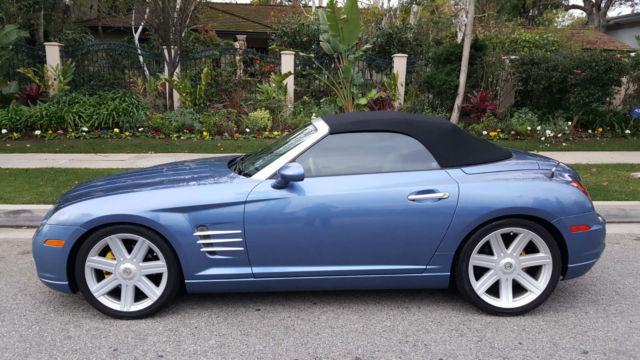
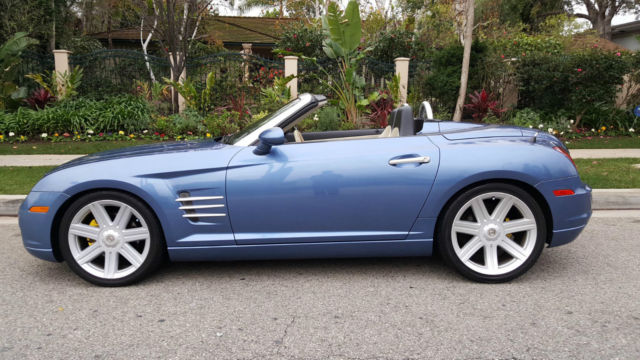
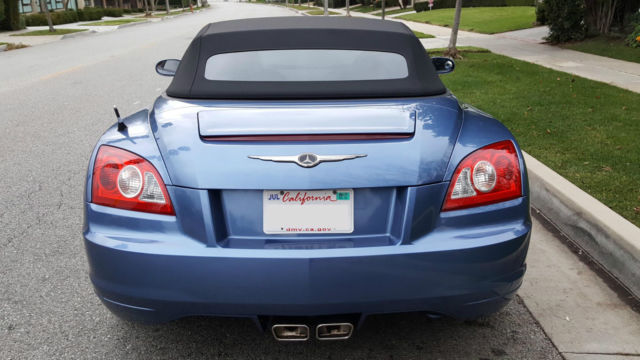
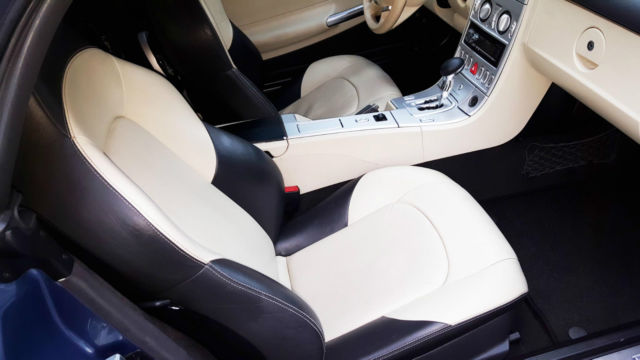

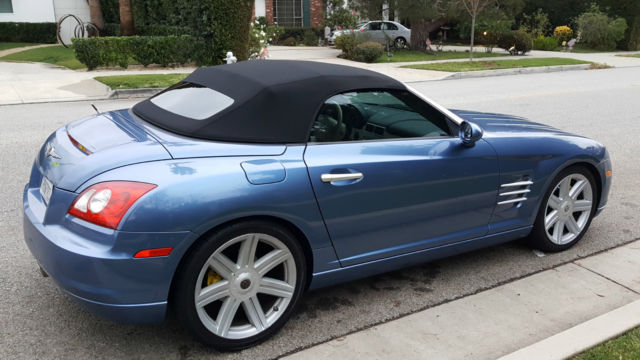
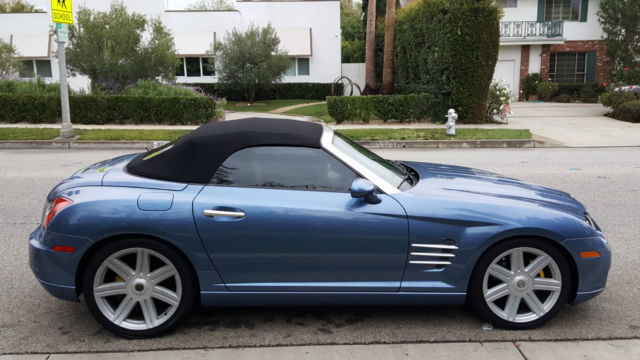
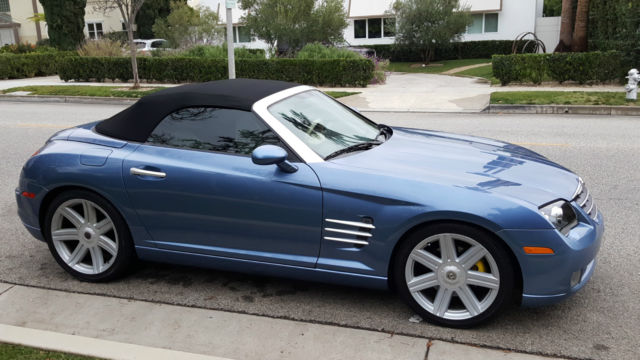
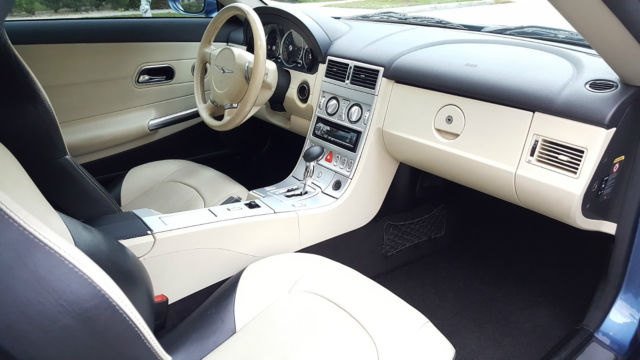
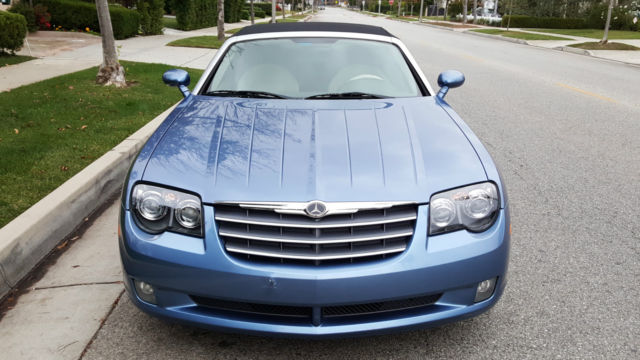
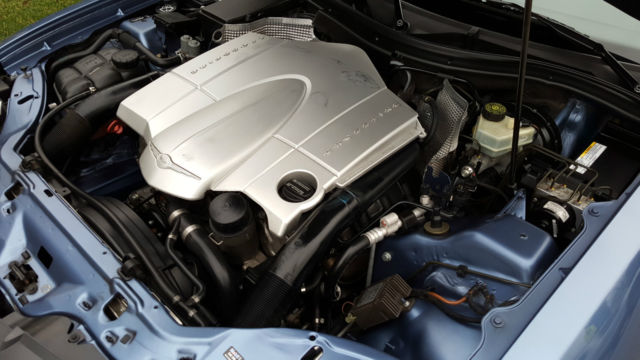
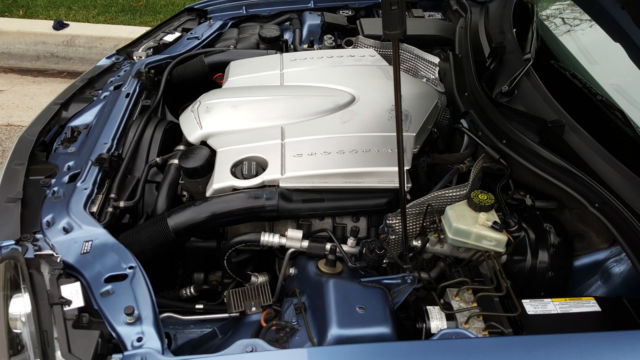
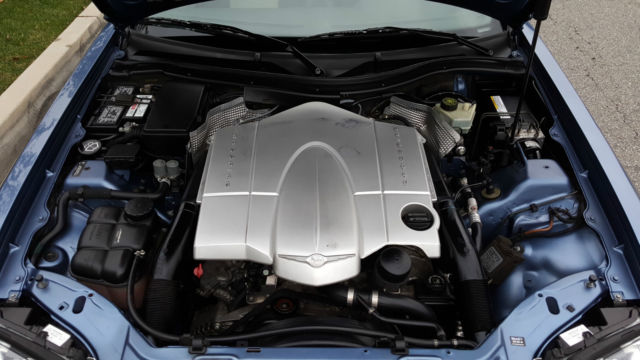
 2005 Chrysler Crossfire Limited 2dr Roadster 100,001 Miles Blue Convertible 3.2L
2005 Chrysler Crossfire Limited 2dr Roadster 100,001 Miles Blue Convertible 3.2L
 Low Mile 2005 Chrysler Crossfire Roadster Limited Sapphire Silver Blue Excellent
Low Mile 2005 Chrysler Crossfire Roadster Limited Sapphire Silver Blue Excellent
 2005 Chrysler Crossfire Base 2dr Roadster 85,994 Miles Red Convertible 3.2L V6 A
2005 Chrysler Crossfire Base 2dr Roadster 85,994 Miles Red Convertible 3.2L V6 A
 2005 Chrysler Blue Crossfire Convertible Only 462 Miles
2005 Chrysler Blue Crossfire Convertible Only 462 Miles
 2005 Chrysler Crossfire Roadster Convertible 22K MILES 3.2L V6 6-Speed Manual
2005 Chrysler Crossfire Roadster Convertible 22K MILES 3.2L V6 6-Speed Manual
 2005 Chrysler Crossfire Limited 2dr Roadster 51,430 Miles White Convertible 3.2L
2005 Chrysler Crossfire Limited 2dr Roadster 51,430 Miles White Convertible 3.2L